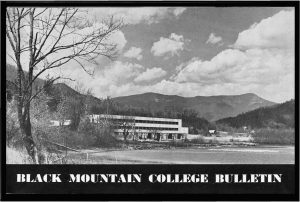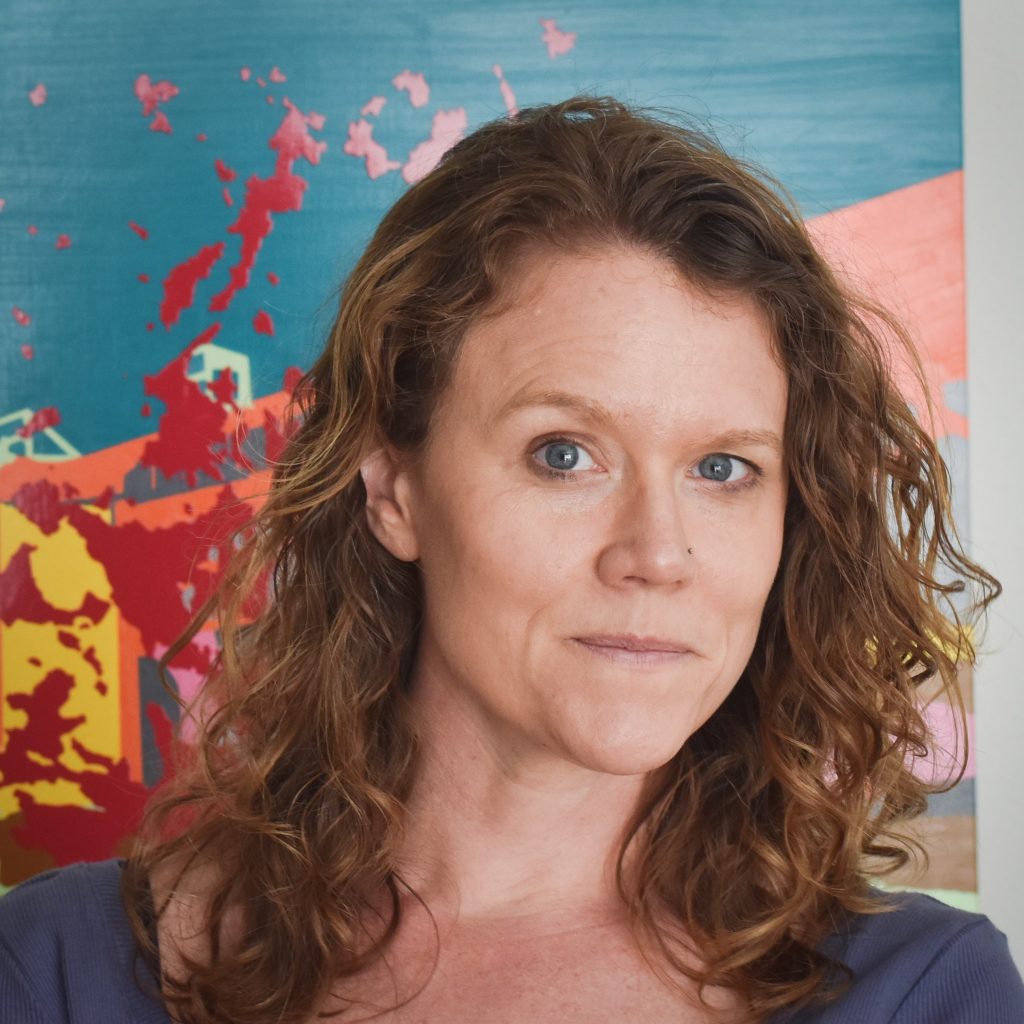But I don’t want to belong to an institution.
—M.C. Richards, “Organization” (1948)
Sometime in 1954, desperate to save Black Mountain College (BMC) from near-certain foreclosure, then-rector Charles Olson sketched a Plan for the Operation of Black Mountain College After 1956 that imagined a “Corporation of Black Mountain College.” At the center of the diagram are four concentric circles. The two smallest represent the physical site of the college and the town of Black Mountain, North Carolina. The wider two demonstrate how various facets of Black Mountain College would expand directionally: the literary magazines Black Mountain Review and Ark go to San Francisco; theater ventures stay in Black Mountain and also move to San Francisco, with additional productions in New York and Cambridge; an academy connected with the Poetry Center is established in San Francisco, with lectures and readings in Boston and Philadelphia and a “Weekend Academy” in New York City; and the painting, drawing, and lithography studios, along with the woodworking, print, pottery, and weaving shops, go to a publishing house connected to Jonathan Williams’s Jargon Press.

At the time, Olson’s plan might have seemed like nothing more than a scheme borne from desperation. Black Mountain College faced perennial financial strain since its founding in 1933 by progressive educator John Andrew Rice and a cohort of fellow professors from Rollins College in Florida. But by the mid-fifties the situation was dire: there wasn’t coal for heat, food for students, or funds for faculty back-pay. From the perspective of predominant literary histories, however, Olson’s diagram appears as a portent of the college’s lasting influence as the ground on which experimental art would thrive. The curator Helen Molesworth describes the diagram as a “dream picture”—an imagination “of a cosmopolitan college of satellite institutions held together by a centripetal force, a myth at its center: Black Mountain College.”1Helen Molesworth, “Imaginary Landscape,” Leap Before You Look: Black Mountain College, 1933-1957, ed. Helen Molesworth (New Haven: Yale University Press, 2015), 51. Such a mythos—encapsulated by the fact that it was at BMC that John Cage organized the first “Happening,” that Buckminster Fuller first tried to raise a geodesic dome, that Ruth Asawa began sculpting with wire, and that Olson penned the first Maximus poems—has become the framework for processing other remembrances of the college. In terms of literary studies, specifically, the circles that ripple from the center “Black Mountain College” in Olson’s diagram indeed might be read as the dream of carrying on, in other locales, the experimental interdisciplinary writing communities that thrived there. As Kevin Power wrote of the poetry community that formed at BMC around such ventures such as the Black Mountain Review: “It clearly didn’t end…. This is the place wherever we are.”2Kevin Power, “In, Around, and About the Black Mountain Review: Robert Creeley and Company,” Black Mountain College: Experiment in Art, ed. Vincent Katz (Cambridge: MIT Press, 2002), 294.
Despite recent attempts to expand the purview of what counts as Black Mountain poetry, “Black Mountain” continues to refer to a group of poets gathered under that label in Donald Allen’s major 1960 anthology New American Poetry, 1945-1960 that shared aesthetic principles but were variously connected to the college—if they were connected to it at all. A true reckoning with the significance of Black Mountain College to literary studies requires a historical and geographical relocation of Black Mountain poetics in the day-to-day operations of the college, its economic and ecological base in eastern Appalachia, and its roles in institutional arts and education networks that spanned the U.S., Germany, and Mexico. Critics such as Lynne Feeley have already pointed out that the reverence for Black Mountain as a hotbed of artistic and pedagogical experiment has obscured the difficult, and often painful, conditions for women writers at the college. Recovering the work and experiences of forgotten BMC poets as well as the college’s entanglements in its environmental and political surrounds, also requires grappling with Black Mountain as an institution of higher education.
One place to start might be to read Olson’s Plan for the Operation of Black Mountain College as both a “dream picture” and, to use the parlance of the contemporary neoliberal university, a strategic plan. In a document written in memory of her husband, founding faculty member Fred Mangold, former BMC registrar Ann Mangold remarked that, in its last years, Black Mountain College “was not really a college.”3Anne Mangold, Untitled typescript, n.d., Box 1502.2, Mr. and Mrs. Frederick Rogers Mangold Papers, North Carolina Western Regional Archives, Asheville, North Carolina. Mangold’s comment squares with narratives commonly deployed in literary studies that mark Olson’s term as BMC rector (1951-1956) as the instantiation of Black Mountain poetry. According to such narratives, the poetry communities that formed at Black Mountain were markedly different from Cold War, university-based creative writing institutions, and any institutional influence on poetics was based in alternative models of community.4See, for example, Stephen Voyce, “Alternative Degrees: ‘Works in OPEN’ at Black Mountain College,” After the Program Era: The Past, Present, and Future of Creative Writing in the University, ed. Loren Glass (Iowa City: University of Iowa Press, 2016), 85-104.
And yet Black Mountain really was a college. While the poetry communities that formed at Black Mountain during the 1950s were in many ways distinct, the notion of a historical and institutional break obscures the potential continuities between the arts-centered progressive education models of Black Mountain’s early years, the experiments in collaborative interdisciplinary practice of the postwar period, and the becoming of the “American MFA industry” (to borrow a term from Mark Nowak). The early writing communities at BMC were informed by the same emerging liberal models that shaped the institutionalization of university creative writing programs during what Mark McGurl has dubbed “the program era”; and later poetry communities were not entirely free from such influence. From this perspective, Olson’s diagram discloses how a far-flung Black Mountain isn’t too far from the operations of a contemporary university that seeks to save itself through austerity measures and territorial expansion. Here, the imperial cybernetic infrastructure that Heriberto Yépez discerns in Olson’s poetics takes institutional form: offering a glimpse of how Black Mountain’s ideals of progressive arts education operated in the syntax of liberal individualism, resource accumulation, market speculation, and imperial expansion.5Heriberto Yépez, The Empire of Neomemory, trans. Jen Hofer, Christian Nagler, and Brian Whitener (Oakland: Chainlinks, 2013). Read this way, Olson’s Plan resets the historical landscape through which the complex realities afforded by the college might be reconsidered.

My epigraph is a line that appears midway through the poet, ceramicist, and educational theorist M.C. Richards’s poem “Organization,” written in 1948 while Richards served on the BMC faculty. In the poem, the wish to “not belong to an institution” emerges from the realization of being enmeshed in one, to the point that: “It gets to be like a minuet or a masque that isn’t a play any longer but the whole show.”6M.C. Richards, Imagine Inventing Yellow (Barrytown, NY: Station Hill Press, 1990), 72. To fully understand the consequences and potentials of Black Mountain’s short-lived experiment, it is necessary to move through the desires and realities of institutional belonging. Constructing a renewed sense of Black Mountain not as an alternative to university-based creative institutions, but from within what Jodi Melamed describes as the “paradox of institutionality,” may make it possible to see in starker relief any potential alterities, collectivities, or radicalisms that existed before the college’s closing as well as in its variegated afterlives.
This essay is part of our cluster on alternative institutions. Visit this page to read the other essays.
Notes
- 1Helen Molesworth, “Imaginary Landscape,” Leap Before You Look: Black Mountain College, 1933-1957, ed. Helen Molesworth (New Haven: Yale University Press, 2015), 51.
- 2Kevin Power, “In, Around, and About the Black Mountain Review: Robert Creeley and Company,” Black Mountain College: Experiment in Art, ed. Vincent Katz (Cambridge: MIT Press, 2002), 294.
- 3Anne Mangold, Untitled typescript, n.d., Box 1502.2, Mr. and Mrs. Frederick Rogers Mangold Papers, North Carolina Western Regional Archives, Asheville, North Carolina.
- 4See, for example, Stephen Voyce, “Alternative Degrees: ‘Works in OPEN’ at Black Mountain College,” After the Program Era: The Past, Present, and Future of Creative Writing in the University, ed. Loren Glass (Iowa City: University of Iowa Press, 2016), 85-104.
- 5Heriberto Yépez, The Empire of Neomemory, trans. Jen Hofer, Christian Nagler, and Brian Whitener (Oakland: Chainlinks, 2013).
- 6M.C. Richards, Imagine Inventing Yellow (Barrytown, NY: Station Hill Press, 1990), 72.

